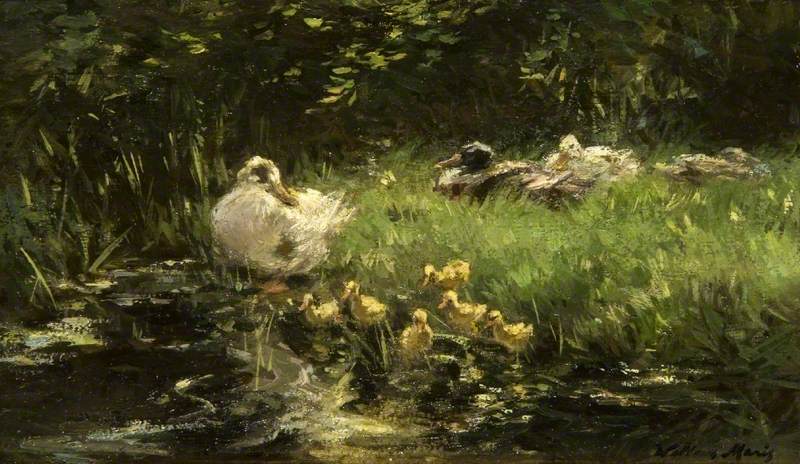Willem Maris (1844-1910) was a Dutch artist, one of three brothers who were all associated with the late 19th century Hague School of painting. They followed a long Dutch tradition of rural landscape which can be traced back to the 17th century, but took their immediate cue from Barbizon landscapists like Theodore Rousseau and Jean-Francois Millet, who sought to represent the countryside and rural life as accurately as possible. The figure engaged in the task in Maris' Milking Time could easily have stepped out of a Millet canvas, hunkered down in anonymous labour amidst countryside which steadfastly refuses to engage in the picturesque.
However, the Hague artists' palette of greys, greens and blues and their cool, even lighting had more in common with the work of French artist Jules Bastien-Lepage, and in this sense the Hague School fits into a wider group of much neglected late 19th century landscapists. Bastien-Lepage's Naturalism was popular in France at the time but doesn't sit easily in an art historical narrative which foregrounds Impressionism. Lepage painted plein air, and his loose brushwork and occasionally awkwardly posed figures seem superficially impressionistic, but he had no interest in modern subject matter, in colour theory, or in promoting himself as an artistic radical. The same could be said of artists like George Clausen in Britain, of the so-called Glasgow Boys in Scotland, and of the Hague School painters in the Netherlands.
Willem Maris' work has the characteristic grey-green palette which led to him and the other Hague artists being nicknamed the Grey School, but the superficial monochrome is broken by vigorous brushwork which reveals complex and often surprisingly vivid colours. Increasingly this sketchiness created a sense of atmospheric haze which gives his paintings a calm lyricism, and the strong sunlight of his work becomes increasingly diffuse.
Maris' early work often involved groupings of multiple figures and animals foregrounded within a characteristically flat, big-skied Dutch landscape. Later, his focus shifted to smaller, more intimate and primarily animal based compositions, including a large number of images of ducks. The big horizons give way to introverted corners of nature, the sky barely visible through complex lattices of leaves and branches, or even completely absent as he seeks out a ground level, creature-eye viewpoint.






No comments:
Post a Comment